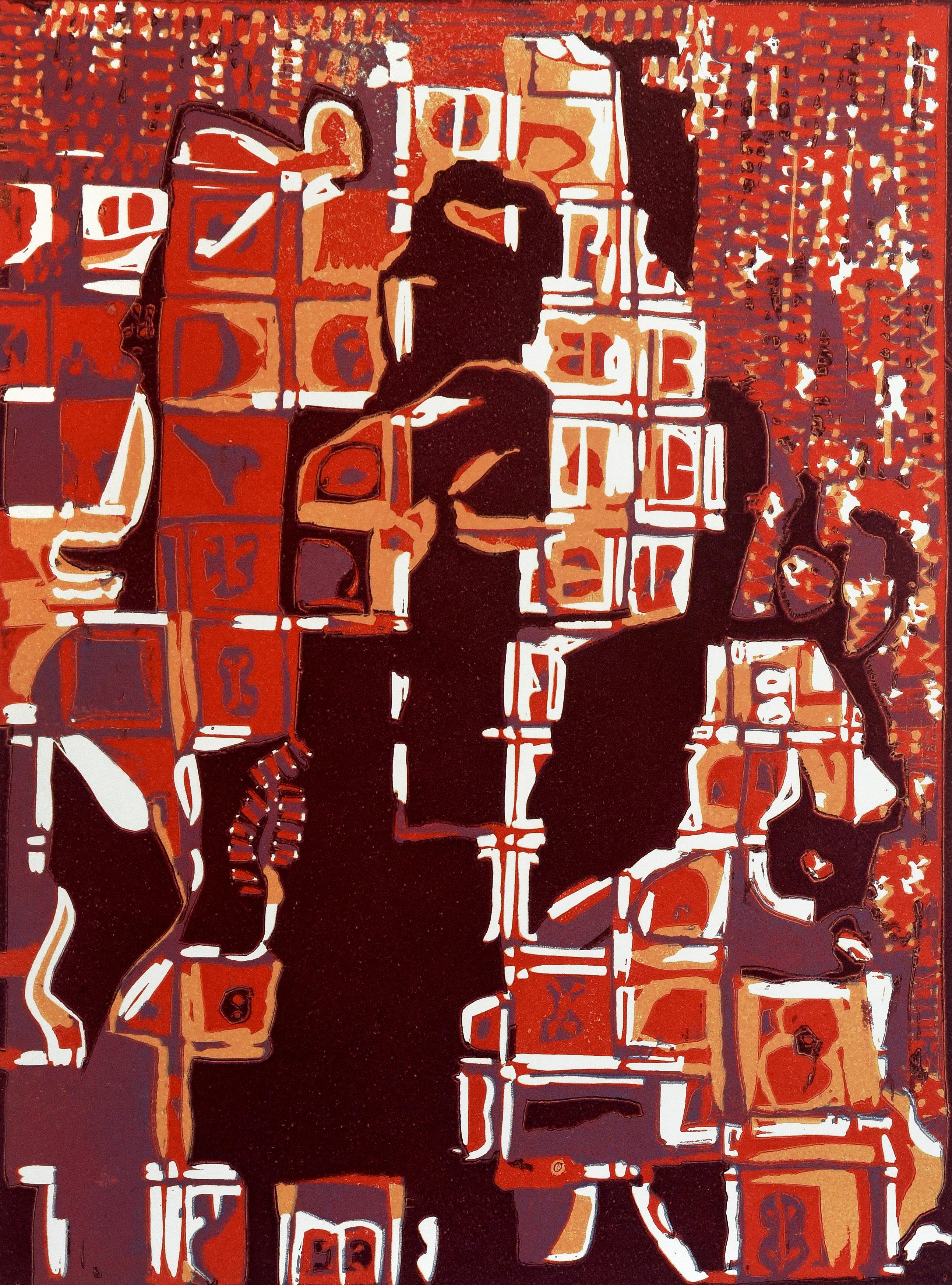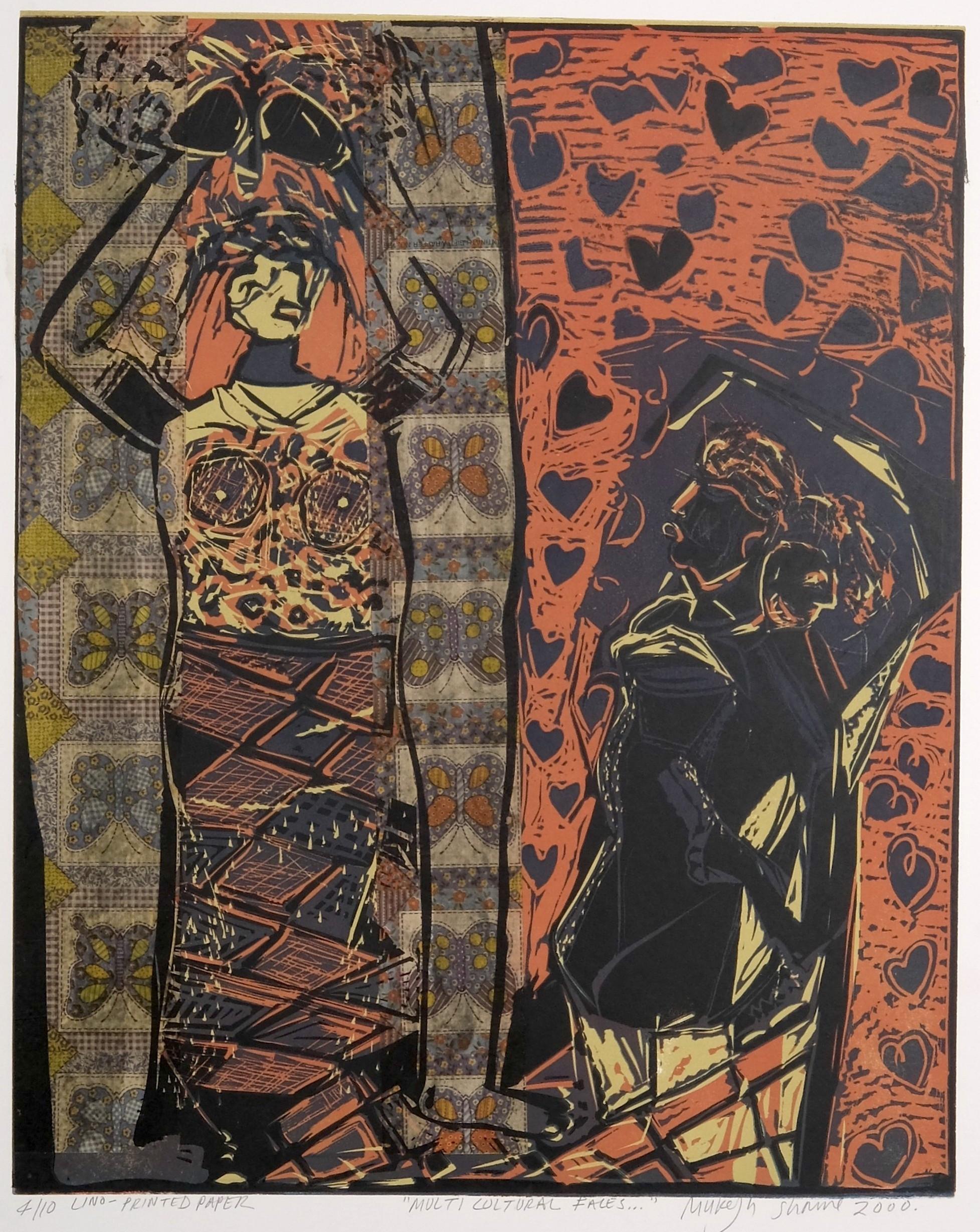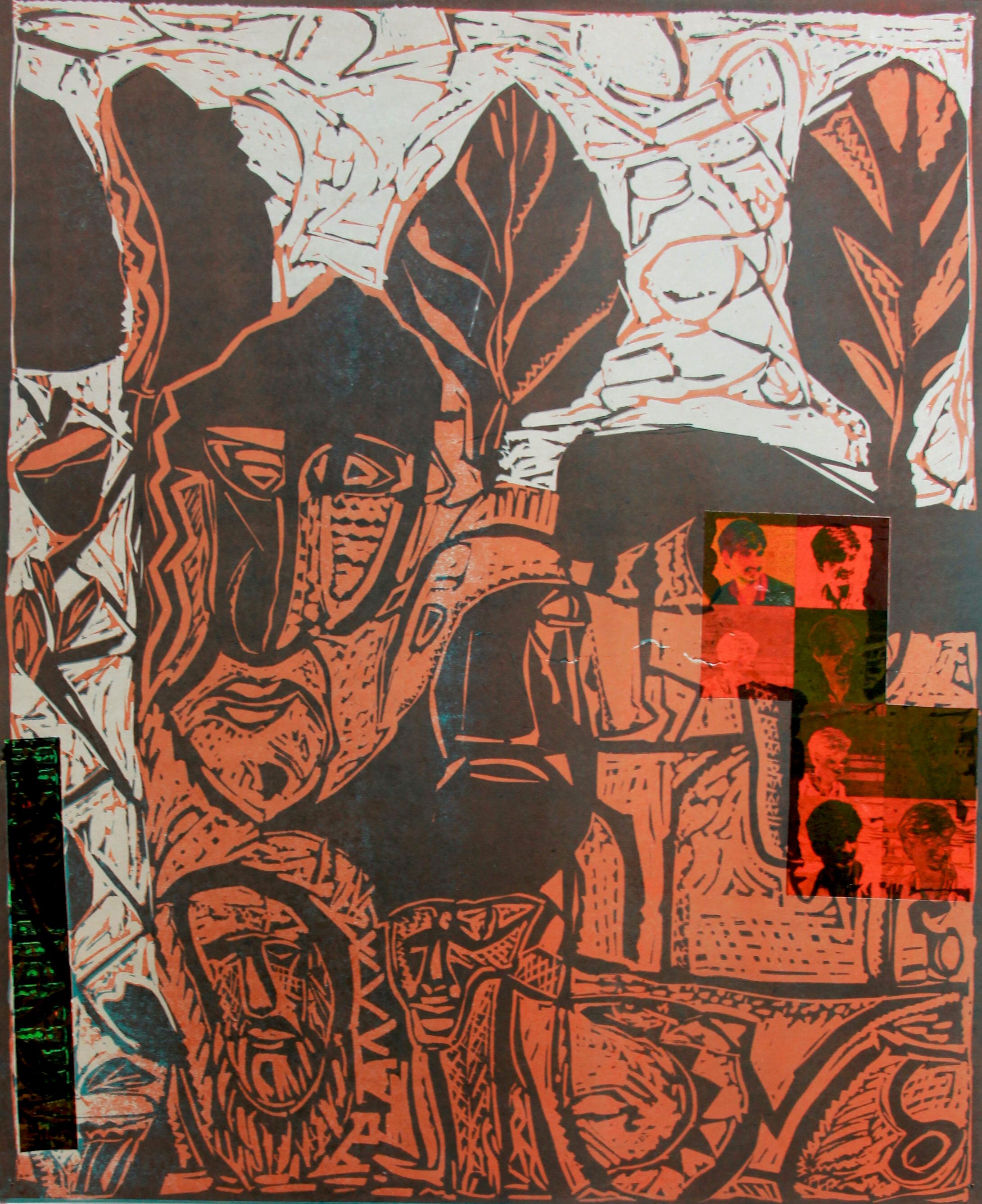Items Similar to After Giuseppe Arcimboldo (Italian 1526-1593). After Vertumnus (1591)
Want more images or videos?
Request additional images or videos from the seller
1 of 6
After Giuseppe Arcimboldo (Italian 1526-1593). After Vertumnus (1591)2022
2022
About the Item
Artist: After Giuseppe Arcimboldo (Italian 1526-1593).
Title: Vertumnus (1591).
Medium: Fine Art High Definition Fusion Metal Print.
Edition: Limited Edition of 25 Prints
Image Size: Height 35.6 cm x Width 28 cm.
Framed Size: Height 44.7 cm x Width 37 cm.
About the Painting:
Vertumnus by Giuseppe Arcimboldo is a portrait of the Holy Roman Emperor Rudolf II as Vertumnus, the Roman god of metamorphoses in nature and life. Produced in 1591 the work uses the form, texture and colour of fruits, vegetables and flowers to create an anthropomorphic painting of the sitter. The unique adaption and unconventional use of perishable foods to create portraiture was more or less an insight into the mind of a Renaissance man whose fascination with riddles, puzzles, and the bizarre would ultimately shape his artistic legacy.
About the Artist:
Giuseppe Arcimboldo (1526-1593) was an Italian Mannerist painter who composed grotesque and surreal compositions out of fruits, vegetables, animals and books, all masterly resembled to create idiosyncratic portraiture. Surrealist artists of the 20th Century would later marvel at Arcimboldo’s painting's aesthetic and intellectual complexities. His painting could be interpreted on multiple fronts and this was an appealing proposal to the surrealists as it allowed the mind to take the image and the imagination to then depart from the conventions of portraiture.
Arcimboldo began his career as a cartoon designer of stained-glass windows for the Milan Cathedral, he then moved to Prague, where he became one of the favourite court painters to the Habsburg rulers Maximilian II and Rudolph II. He painted works for the court theatres and he began to establish a reputation as a master of illusion and trickery. Often his works contained allegorical references along with more light-hearted jokes and puns. Giuseppe Arcimboldo had an eccentric vision that left its mark on the 16th Century and went on to further influence movements in the 20th century that are still relevant in popular culture of today.
Vertumnus - A Different Perspective: This print has been selectively enhanced from high-resolution photography to produce a unique and contemporary perspective of Giuseppe Arcimboldo’s “Vertumnus”. With selective cropping, we capture the essential elements of the composition that make the painting work. Printed on metal also mirrors one of the mediums used during this period. Each Fine Art High Definition Fusion Metal Print is limited to an edition of 25 and is supplied with a Wright Gallery Editions Certificate of Authenticity.
Fine Art High Definition Fusion Metal Print: Through an innovative dye sublimation process, this image has been infused into specially coated HD metal to provide the most durable print medium with ultimate image clarity, vibrancy and lifetime longevity rating. Each Fine Art High Definition Fusion Metal Print is framed in a quality classic period style black ebony wooden frame with a gold edge slip that looks elegant in either a period or contemporary setting. Easy to care for, wipe clean with a cloth, no glass, no reflections. The materials and longevity of this process make this artwork suitable to hang in areas of humidity and temperature change such as kitchens and bathrooms.
- Creation Year:2022
- Dimensions:Height: 17.6 in (44.7 cm)Width: 14.57 in (37 cm)Depth: 1.97 in (5 cm)
- More Editions & Sizes:Image Size: Height 35.6 cm x Width 28 cm.Price: $850
- Medium:
- Movement & Style:Old Masters
- After:Giuseppe Arcimboldo (Milan 1527 - Milan 1593) (1527 - 1593, Italian)
- Period:16th Century
- Condition:
- Gallery Location:Sydney, AU
- Reference Number:1stDibs: LU1971211286942
About the Seller
No Reviews Yet
Vetted Seller
These experienced sellers undergo a comprehensive evaluation by our team of in-house experts.
Established in 2011
1stDibs seller since 2022
- ShippingRetrieving quote...Ships From: Sydney, Australia
- Return PolicyA return for this item may be initiated within 7 days of delivery.
More From This SellerView All
- After Giuseppe Cesari (1568-1640) After St George Slaying the DragonBy Giuseppe CesariLocated in Sydney, NSWAbout the Painting: St George Slaying the Dragon is a genre painting derived from the legend, St George, a soldier venerated in Christianity who battles and defeats a dragon. The tale recalls a dragon who extorted a village of their worldly possessions, once the villagers had depleted all their livestock, money and trinkets they began to sacrifice humans to the dragon as a tribute once a year. The villagers were content with the arrangement until a princess was chosen as the next offering. St George then rescues the princess and ultimately he slays the dragon, thus liberating the oppressed villages. A moral anecdote of good over evil and a genre work that has been explored by artists since its conception, with iconography throughout European art movements for hundreds of years and still up until this day. About the Artist: Giuseppe Cesari...Category
16th Century Old Masters Figurative Prints
MaterialsMetal
- After Giuseppe Cesari (Italian 1568-1640) St. George Slaying the DragonBy Giuseppe CesariLocated in Sydney, NSWArtist: After Giuseppe Cesari (Italian 1568-1640) Title: St. George Slaying the Dragon Medium: Giclée Fine Art Print on Ilford Galerie Textured Cotton ...Category
16th Century Old Masters Figurative Prints
MaterialsArchival Ink, Rag Paper
- The United StatesLocated in Sydney, NSW19th Century chromolithograph, The United States (Vanity Fair), under the pseudonym of ApeCategory
19th Century Academic Figurative Prints
MaterialsLithograph
- John II, Count of Hainaut Holland & Zeeland (1247-1304)Located in Sydney, NSW18th Century (c1740) etching/engraving , John II, Count of Hainaut Holland & Zeeland (1247-1304)Category
19th Century Academic Figurative Prints
MaterialsEngraving, Etching
- Monkey (Edition 33/100 Dated 1959)Located in Sydney, NSWArtist: Thomas Cornell (American 1937-2012) Title: Monkey (Edition 33/100 Dated 1959) Medium: Etching on paper Condition: This work is in good condition, in its original frame. Provenance: Private Collection New York About: Cornell was known for empirical drawings and paintings. His work involved moral content concerning global, social, and environmental justice. He was the Richard E. Steele Artist-in-Residence at Bowdoin College...Category
Mid-20th Century American Modern Animal Prints
MaterialsEtching, Paper
- After Hans Holbein the Younger (German 1497-1543), King Henry VIIILocated in Sydney, NSWArtist: After Hans Holbein the Younger (German 1497-1543). Title: King Henry VIII of England. Limited Edition of 25. Medium: Fine Art High Definition Fusion Metal Print. Edition: Limited Edition of 25 Prints Image Size: Height 35.6 cm x Width 28 cm. Framed Size: Height 44.7 cm x Width 37 cm. About: Hans Holbein the Younger was born in Augsburg Germany in 1497, a painter and printer working in the Northern Renaissance style. Considered one of the pre-eminent portrait painters of the 16th century In 1526 Holbein travelled to England and quickly build a reputation as a fine portraitist. He then spent four years in Basel returning to England in 1532 to work for Anne Boleyn and Thomas Cromwell...Category
16th Century Old Masters Portrait Prints
MaterialsMetal
You May Also Like
- Abstract Landscape India Edition 3/5 Linocut Print Nature Red Orange BlackBy Mukesh SharmaLocated in Norfolk, GBThere is a natural and raw understanding in Mukesh Sharma’s prints that both depict, and are influenced by, the Rajastani communities of his home town in rural India. In these Limited Edition fine-art prints, made over a period of twenty years, we are offered the colours of India’s ancient land, the textures, light and the patterns that are everywhere. In the patterns of the arable fields to the jali's (carved screens) in the architecture. This work is however not romantic nor nostalgic but shows a deeper rooted need to offer a visual heritage of place, of where the artist is from and the journey that he is taking. The results are both compelling and honest. Mukesh Sharma, Celebration “O”, Lino-cut chin-coll’e on German Ivory paper Edition: 3 of 5, 2005 Image size: 50 x 33 cm / Sheet size: 79 x 55 cm Unframed "In this piece I use multiple layering of image, repetition of shape, layered shapes to inform my life celebration and my investigation into Indian culture" Mukesh Sharma's work: It is often in childhood that paths are set for what we will become. Mukesh Sharma hails from a rural, agricultural village in Rajasthan, India. His Father is a craftsman who fixed and mended farm machinery and understood the working parts in the processes. Sharma followed in his Father’s footsteps, as is often the case in Indian families, but his was not the machines of the fields but the presses of the printing studio. Like his Father, Mukesh Sharma is fascinated with understanding how things work and how he can manipulate the metal in his hands. It is not surprising then that his medium of choice is printing. One of the most physically challenging of all the practices, it can often be physically challenging as well as technical and detailed. In his youth, Sharma would draw with stones on walls and floors. He was lucky his family encouraged this and he is grateful for his early art-training at the Jaipur School of Art but it was at the Baroda Art Department that he was introduced to the great printing traditions of Jyoti Bhatt...Category
Early 2000s Abstract Abstract Prints
MaterialsArchival Ink, Archival Paper, Linocut, Archival Pigment
- Abstract India Edition 3/5 Linocut Print Nature Love Purple Blue TurquoiseBy Mukesh SharmaLocated in Norfolk, GBThere is a natural and raw understanding in Mukesh Sharma’s prints that both depict, and are influenced by, the Rajastani communities of his home town in rural India. In these Limite...Category
Early 2000s Abstract Abstract Prints
MaterialsArchival Ink, Archival Paper, Linocut, Archival Pigment
- Abstract Landscape India Edition 3/5 Linocut Print Nature Red Navy PrimitiveBy Mukesh SharmaLocated in Norfolk, GBThere is a natural and raw understanding in Mukesh Sharma’s prints that both depict, and are influenced by, the Rajastani communities of his home town in rural India. In these Limited Edition fine-art prints, made over a period of twenty years, we are offered the colours of India’s ancient land, the textures, light and the patterns that are everywhere. In the patterns of the arable fields to the jali's (carved screens) in the architecture. This work is however not romantic nor nostalgic but shows a deeper rooted need to offer a visual heritage of place, of where the artist is from and the journey that he is taking. The results are both compelling and honest. Mukesh Sharma, Frenzy M3, Lino-cut chin-coll’e on German Ivory paper Edition: 3 of 5, 2005 Image size: 50 x 33 cm / Sheet size: 79 x 55 cm Unframed 'In this work in particular I feel that a true work of art is the creation of an experience from the interaction between the human self and the outside world' Mukesh Sharma's work: It is often in childhood that paths are set for what we will become. Mukesh Sharma hails from a rural, agricultural village in Rajasthan, India. His Father is a craftsman who fixed and mended farm machinery and understood the working parts in the processes. Sharma followed in his Father’s footsteps, as is often the case in Indian families, but his was not the machines of the fields but the presses of the printing studio. Like his Father, Mukesh Sharma is fascinated with understanding how things work and how he can manipulate the metal in his hands. It is not surprising then that his medium of choice is printing. One of the most physically challenging of all the practices, it can often be physically challenging as well as technical and detailed. In his youth, Sharma would draw with stones on walls and floors. He was lucky his family encouraged this and he is grateful for his early art-training at the Jaipur School of Art but it was at the Baroda Art Department that he was introduced to the great printing traditions of Jyoti Bhatt...Category
Early 2000s Abstract Abstract Prints
MaterialsArchival Ink, Archival Paper, Linocut, Archival Pigment
- Abstract Landscape Rajasthan Print Nature Multicultural Faces Earth Orange BrownBy Mukesh SharmaLocated in Norfolk, GBThere is a natural and raw understanding in Mukesh Sharma’s prints that depict, and are influenced by, the Rajastani communities of his home town in rura...Category
Early 2000s Abstract Abstract Prints
MaterialsArchival Ink, Archival Paper, Linocut, Archival Pigment
- Abstract Landscape India Edition 3/5 Linocut Print Nature Green Yellow LeavesBy Mukesh SharmaLocated in Norfolk, GBThere is a natural and raw understanding in Mukesh Sharma’s prints that both depict, and are influenced by, the Rajastani communities of his home town in rural India. In these Limited Edition fine-art prints, made over a period of twenty years, we are offered the colours of India’s ancient land, the textures, light and the patterns that are everywhere. In the patterns of the arable fields to the jali's (carved screens) in the architecture. This work is however not romantic nor nostalgic but shows a deeper rooted need to offer a visual heritage of place, of where the artist is from and the journey that he is taking. The results are both compelling and honest. Mukesh Sharma, Untitled, Lino-cut chin- coll’e on German Ivory paper Edition: 3 of 5, 1999 Image size: 50 x 33 cm / Sheet size: 79 x 55 cm Unframed 'This work reminds me of my childhood and early youth, growing up in a village that was full of nature, surrounded by lush green. The towering Aravalli hills left a strong impression on me.' Mukesh Sharma's work: It is often in childhood that paths are set for what we will become. Mukesh Sharma hails from a rural, agricultural village in Rajasthan, India. His Father is a craftsman who fixed and mended farm machinery and understood the working parts in the processes. Sharma followed in his Father’s footsteps, as is often the case in Indian families, but his was not the machines of the fields but the presses of the printing studio. Like his Father, Mukesh Sharma is fascinated with understanding how things work and how he can manipulate the metal in his hands. It is not surprising then that his medium of choice is printing. One of the most physically challenging of all the practices, it can often be physically challenging as well as technical and detailed. In his youth, Sharma would draw with stones on walls and floors. He was lucky his family encouraged this and he is grateful for his early art-training at the Jaipur School of Art but it was at the Baroda Art Department that he was introduced to the great printing traditions of Jyoti Bhatt...Category
Early 2000s Abstract Abstract Prints
MaterialsArchival Ink, Archival Paper, Linocut, Archival Pigment
- Abstract India Edition 5/8 Linocut Print Nature Orange Black Red LoveBy Mukesh SharmaLocated in Norfolk, GBThere is a natural and raw understanding in Mukesh Sharma’s prints that both depict, and are influenced by, the Rajastani communities of his home town in rural India. In these Limited Edition fine-art prints, made over a period of twenty years, we are offered the colours of India’s ancient land, the textures, light and the patterns that are everywhere. In the patterns of the arable fields to the jali's (carved screens) in the architecture. This work is however not romantic nor nostalgic but shows a deeper rooted need to offer a visual heritage of place, of where the artist is from and the journey that he is taking. The results are both compelling and honest. Mukesh Sharma, Voted Dyas II, Lino-cut/ chine colle, on German Ivory paper Edition: 5 of 8, 1999 Image size: 47 x 39 cm / Sheet size: 79 x 55 cm Unframed 'We belong where love finds us' Mukesh Sharma's work: It is often in childhood that paths are set for what we will become. Mukesh Sharma hails from a rural, agricultural village in Rajasthan, India. His Father is a craftsman who fixed and mended farm machinery and understood the working parts in the processes. Sharma followed in his Father’s footsteps, as is often the case in Indian families, but his was not the machines of the fields but the presses of the printing studio. Like his Father, Mukesh Sharma is fascinated with understanding how things work and how he can manipulate the metal in his hands. It is not surprising then that his medium of choice is printing. One of the most physically challenging of all the practices, it can often be physically challenging as well as technical and detailed. In his youth, Sharma would draw with stones on walls and floors. He was lucky his family encouraged this and he is grateful for his early art-training at the Jaipur School of Art but it was at the Baroda Art Department that he was introduced to the great printing traditions of Jyoti Bhatt...Category
Early 2000s Abstract Abstract Prints
MaterialsArchival Ink, Archival Paper, Linocut, Archival Pigment
Recently Viewed
View AllMore Ways To Browse
Kitchen Prints
Milan Antique
Italian Food Art
Italian Old Books
Old Antique Bathroom
Surreal Italian
Old Antique Windows
Bathroom Prints
Old Glass Windows
Italian Renaissance Style Art
Antique Black Paint For Metal
Prague Art Print
Window Mirror Antique
Ebony Wooden
Vegetable Print
Man Cloth
Italian Grotesque
Grotesque Print





